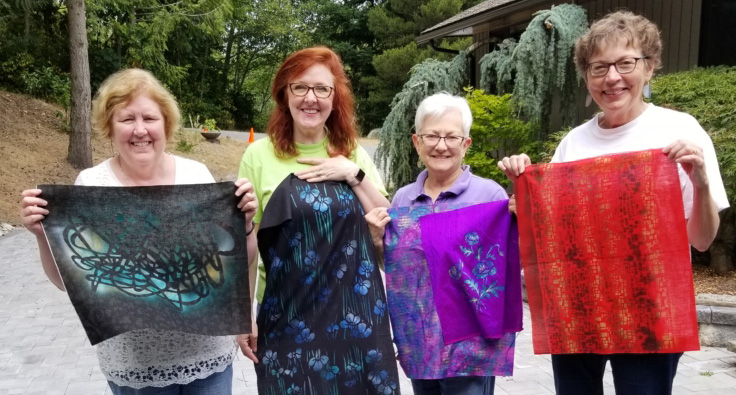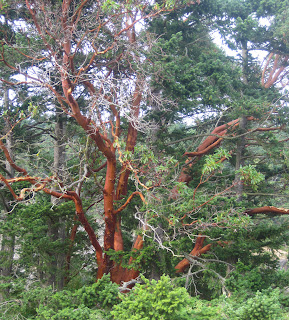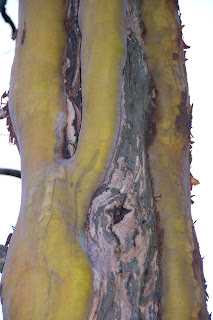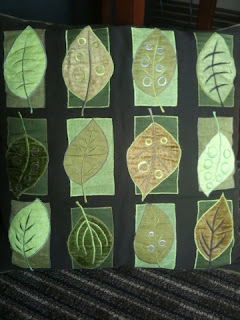UK Day 2- London’s Fashion and Textile Museum
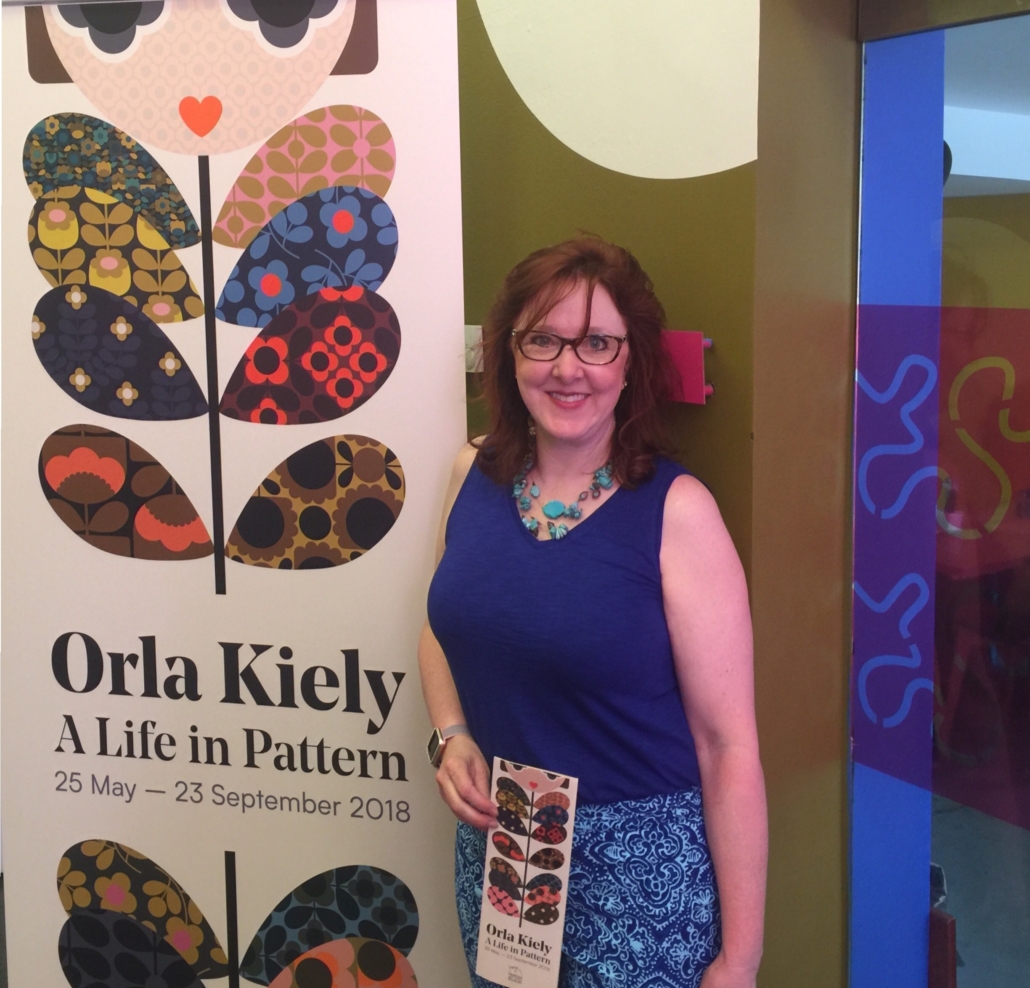
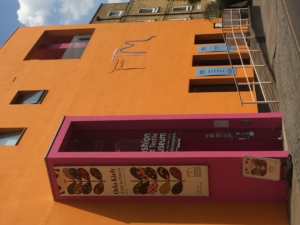 The last time I visited London, I found this wonderful little gem of a museum in the Southwark neighborhood. This visit, they are featuring the work of Orla Kiely, one of Ireland and the UK’s most famous fashion designers, a perfect blend after just completing my trip to Ireland!
The last time I visited London, I found this wonderful little gem of a museum in the Southwark neighborhood. This visit, they are featuring the work of Orla Kiely, one of Ireland and the UK’s most famous fashion designers, a perfect blend after just completing my trip to Ireland!
Orla Kiely studied textile design in Dublin in the early 1980’s and received her MA from the Royal College of Art in 1992. Having grown up in Ireland in the 60’s and 70’s, Orla’s design are influenced by the styles, colors and patterns of that era.

Designs from Orla’s college years
Nature inspires many of Kiely’s repeating patterns. Her “Stem” pattern has become an iconic design, catapulting Kiely into International design success in 2000.
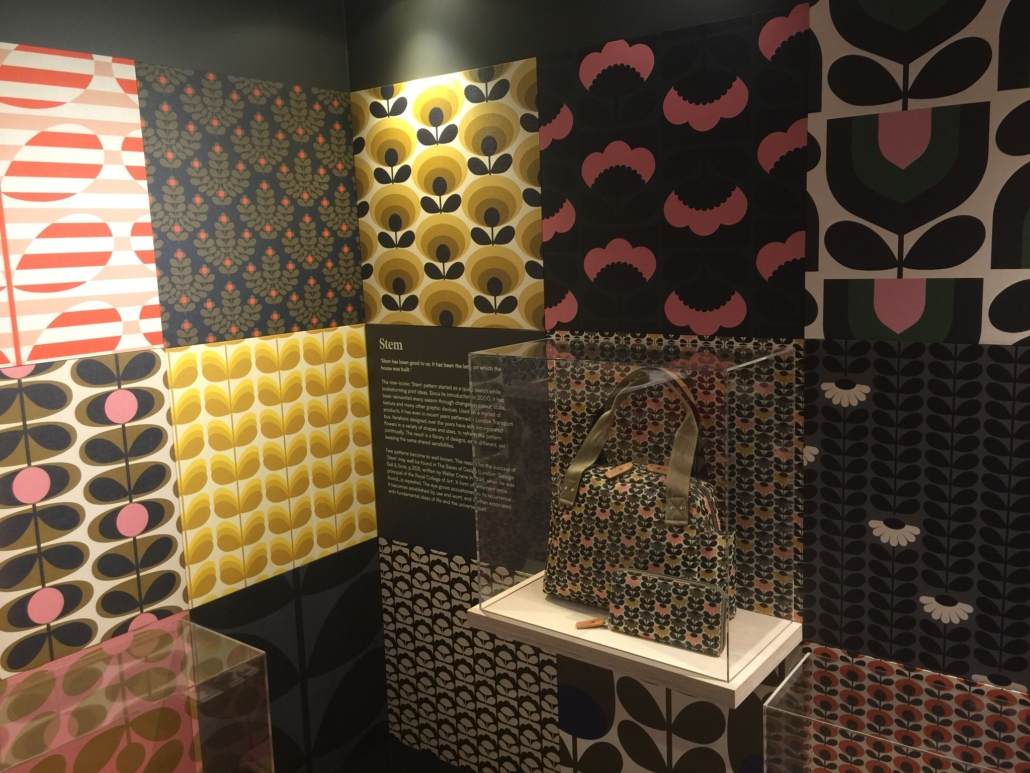
Display of different iterations of Orla Kiely’s Stem pattern.
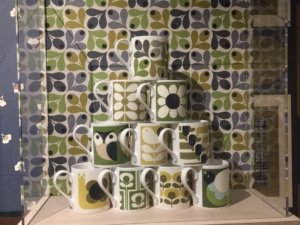
Coffee mug collection featuring Orla’s designs.
Her designs are based in rhythmic and repetitive pattern, now popular in accessories, handbags, wallpaper, and home decor, as well as her seasonal fashion collections.
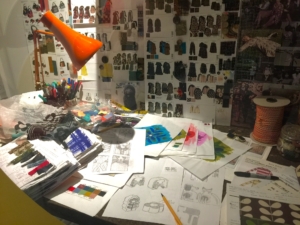
From the desk of Orla Kiely
Changes of scale, coordinating colors (often in a 1970’s palette, including avocado green, harvest gold, orange and chocolate brown), and whimsical, near-abstract depictions of animals are all common elements that make Orla’s designs unique and distinguishable. The exhibition includes over 150 patterns and products and is well worth attending!
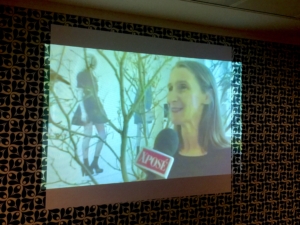
Filmed videos of Orla describing her inspirations, creative process, and collections, as well as footage of her fashion collection engage the audience in a multi media experience.
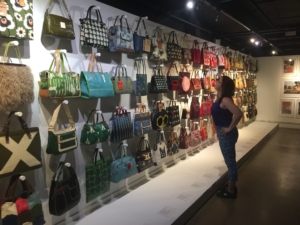
Christina surveying a display of Orla Kiely handbags
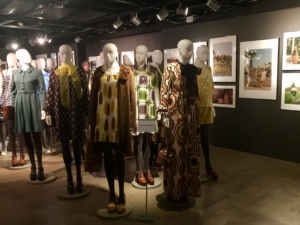
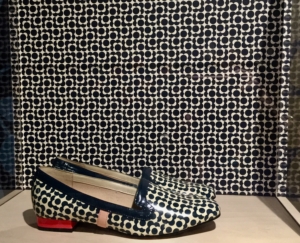
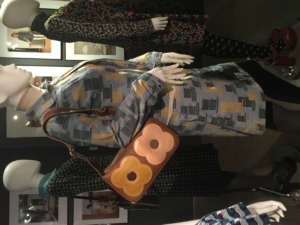

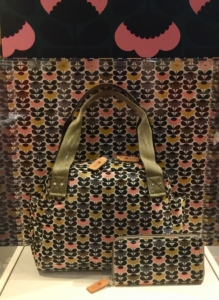
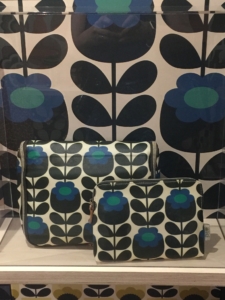

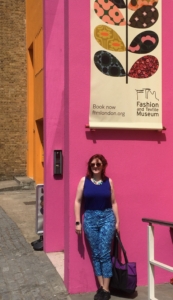
Day 7: The Mill at Avoca Village

Hand loom with weft threads and shuttles
About a month before my trip to Ireland, I get a text from my friend Pam Olney ( @quiltersgarden ) who was currently IN Ireland. She told me I had to add Avoca Handweavers as a stop on my trip. I love getting recommendations from my fiber art friends!
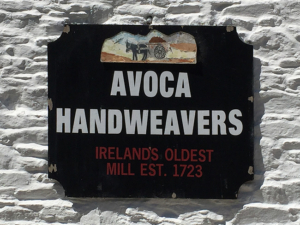
Established in 1723, Avoca is the oldest mill in Ireland still in production. Although it has gone through it’s ups and downs, Avoca Handweavers is now a thriving International business, employing over 800 people. While there are 10 Avoca retail locations around Ireland, the Avoca village location allows you to tour the old mill, the current weaving production facility, as well as having both a wonderful café and giftshop.

In background, the threads are fed in the correct sequence onto the “Swift” and then onto a “Beam”, like a giant spool for warping the loom. The beam is then lifted onto the loom to be “tied in.” It can take up to 2 days to complete the setting up of a warp.
The mill displays old weaving equipment, educational displays, explanations of the different processes, as well as modern equipment in use.
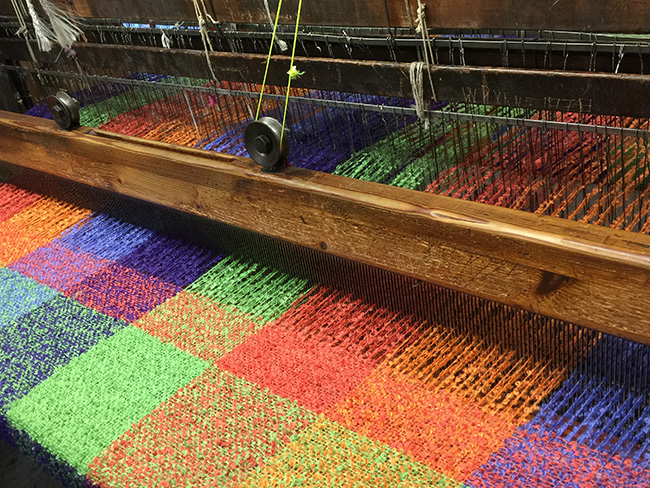
Beautiful color blending combining warp & weft
Here’s a short video from our visit to the mill showing the power looms, cutting and fringing machines in action:
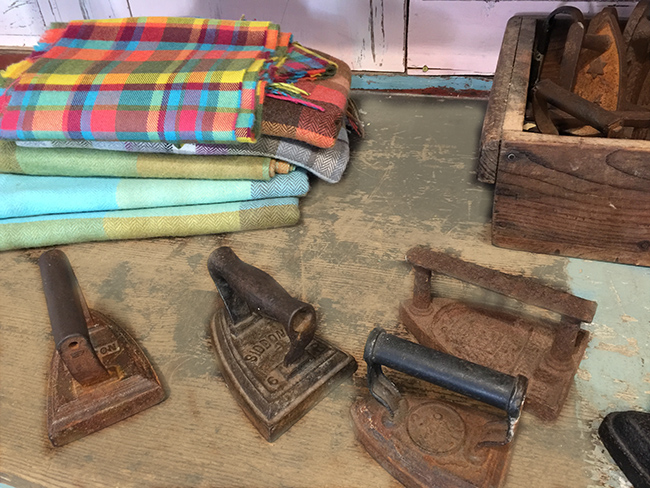
Antique Irons on display
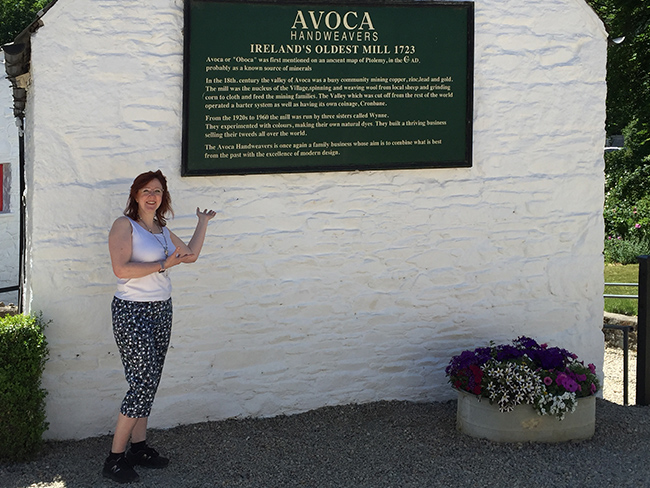
Christina with the Avoca Handweavers sign at Ireland’s Oldest Mill
Day 5 – Giants’ Causeway and the Dark Hedges
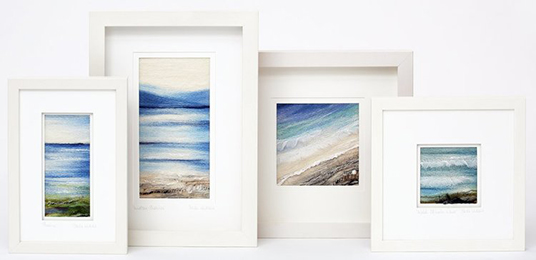
Seascapes series © Breda McNelis, fiber artist https://bredamcnelis.ie/
As a member of one of my favorite organizations, the Contemporary Quilt Art Association, I’m hoping to enter an exhibition next year called “Natural Geometry”. Boy, do I have inspiration to tackle that theme! A World Heritage site, the Giant’s Causeway is comprised of polygonal basalt blocks, most frequently 6-sided but some have 4, 5, 7, or 10 sides.
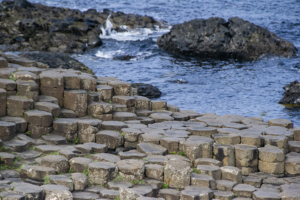
Basalt rock formations at the Giant’s Causeway, Northern Ireland
The legend behind the name of this geological wonder goes as follows. The giant from Ireland, Fionn mac Cumhaill (aka Finn McCool) is being threatened by the Scottish giant Benandonner across the sea. Finn grabs up huge rock pieces from the coastline and throws them into the sea, to make a pathway for Finn to go across. However, when he gets across, he realizes that Benandonner is terrifyingly massive! Finn rushes back home to Ireland where his wife disguises him as a baby. When the Scottish giant comes to their door and sees McCool as a baby, he thinks the father must be much larger than he is, so he races back across the rock bridge to Scotland, causing most of the bridge to sink!
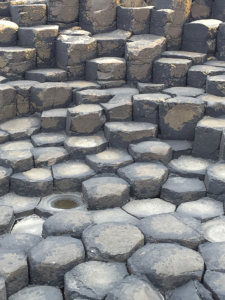
The Giant’s steps
One of the things that surprised and delighted me was the gift shop and interpretative center. Rather than just have the typical tourist doodads, they had a wide variety of quality artwork from local artisans, fiber art included!

Giant’s Causeway © Breda McNelis
Breda McNelis is one of the textile artists that are represented by the shop. Her work is inspired by the colors and textures of the Irish landscape. She also works with traditional Irish fabrics- Báinín, a traditional Irish fabric which is an un-dyed, woven 100% natural wool and colorful Donegal tweeds. Her pieces are layered with silk fibers, hand-painted silks, merino wool, and beautiful yarns.
You can find more of her lovely work on her website at https://bredamcnelis.ie/
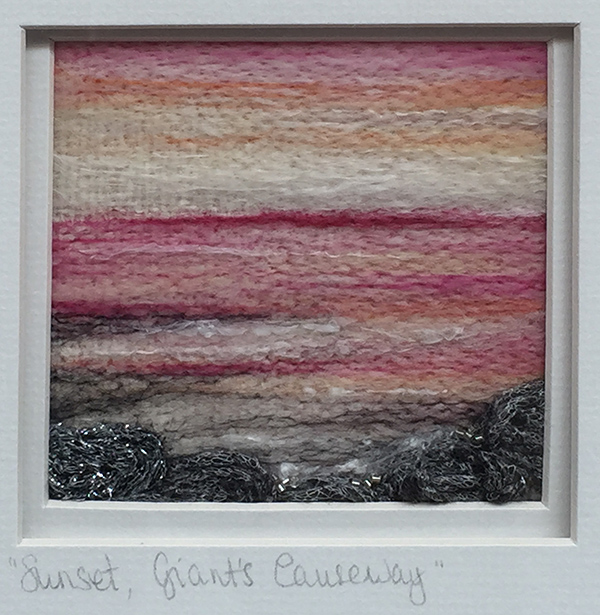
“Sunset, Giant’s Causeway” © Breda McNelis

Christina Fairley Erickson at the Giant’s Causeway
The mystery and magic of the Causeway Coastal area at the North-western edge of Ireland has drawn tourists for 400 years, but most recently has gained greater fame from the Game of Thrones series. With the abundance of medieval buildings, beautiful landscapes, and mysterious caves, Northern Ireland became a natural location for filming this fantasy mega-hit.
One of the locations, “The Dark Hedges”, was used as the Kingsroad for the people of Westeros and was shown in Season 2, Episode 1 when Arya Stark escaped King’s Landing in the back of a cart. Planted in the 18th century, the intertwining beech trees create a spooky, other-worldly setting.
In 2016, storm Gertrude hit Northern Ireland with 130 km/hr winds, causing a number of the trees to fall. But the creative genius of the people of this area took this tragedy and made something beautiful out of it. The huge trunks were removed and a group of designers and craftsmen interpreted different scenes from the Game of Thrones Session 6 into a series of 10 incredibly carved doors. Each of the doors were then installed at a pub at a Game of Thrones film location in Northern Ireland. Click here to see a short film on the making of the Doors of Thrones.
Coming soon: Blog on the “Game of Thrones Tapestry”!
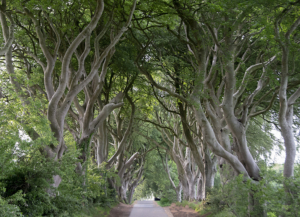
The Dark Hedges aka the Kings Road in the Game of Thrones
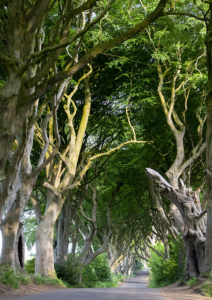
The soaring and mysterious Dark Hedges

Towering columns of the Giant’s Causeway
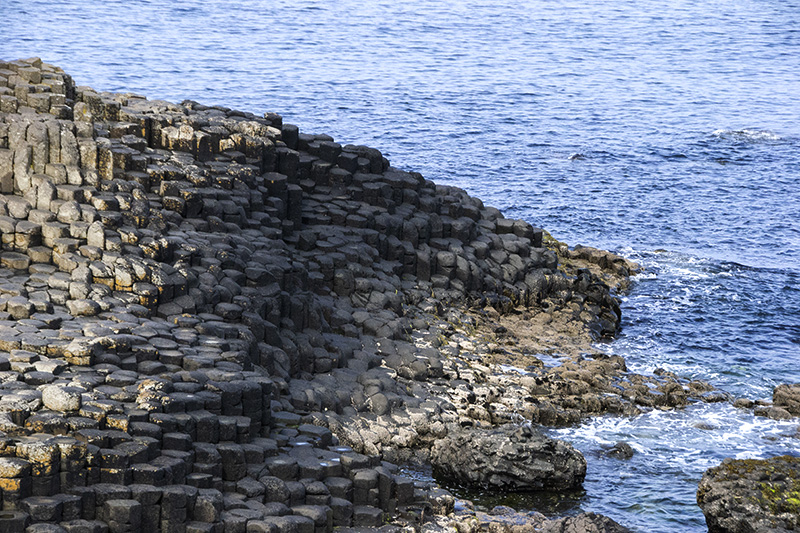
The Giant’s Causeway steps into the Inner Sea between Northern Ireland and Scotland

One of many wooded lanes lending to the mystical atmosphere in Northern Ireland
Day 2- Dublin, Ireland
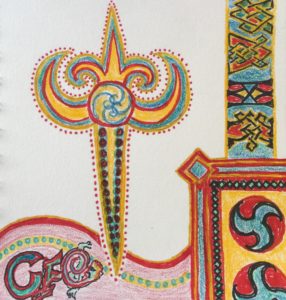
Design inspired by the Book of Kells by Christina Fairley Erickson
We started our day by walking over to Trinity College, to visit the Book of Kells Museum. A beautifully preserved illuminated manuscript created around 800 C.E., the book includes the four books of the gospels- Matthew, Mark, Luke and John.
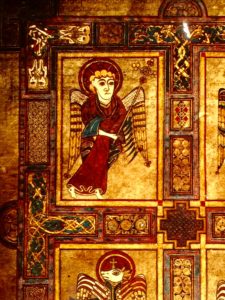
Depiction of Matthew, Book of Kells, folio 27v
The museum hosts incredible displays of many of the intricate illuminated pages, the processes and materials that were used in making the book, as well as information on the few other manuscripts still surviving from about the same period in history. The treasury in the museum displays both the Book of Kells and the Book of Armagh, also from the 800’s.
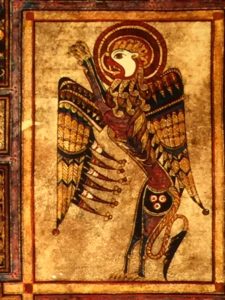
Symbol of ‘the lion of Mark’, Book of Kells, folio 27v
Due to the delicate nature of the volumes, the Book of Kells is split in two parts, with one section open to an illuminated page and the second open to two of the pages of ancient Medieval Latin script. They change which pages are displayed every three months (and it takes several hours to do it, with all the precautions they have to take!) The Book of Armagh is much smaller in size than the Book of Kells. It contains the New Testament of the Bible in minuscule calligraphic text, without illumination.
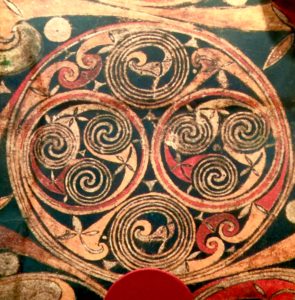
Part of a display at the Book of Kells Museum showing details of circles and swirls along with pieces of jewelry from the same time period with similar Celtic imagery
One thing I found fascinating was the information on the different inks they used… they even had a purple ink- a very rare color in medieval times.
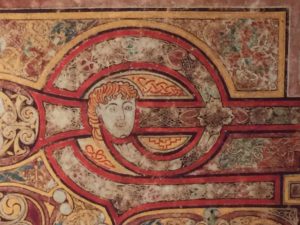
The ‘Chi Rho’ page using the Greek monogram of the name of Christ. Book of Kells, folio 34r
The twisting sinuous Centic knots and designs are masterfully executed- most likely by young monks, 15-19 years old or so, as they would have had the best eyesight. There are also some other details that also lead to this conclusion, such as tiny farcical characters such as two cats overlooking mice fighting over what appears to be a communion wafer!
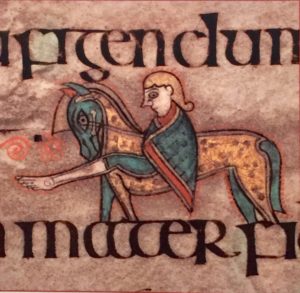
Here are a few more images to enjoy from this inspiring design source!
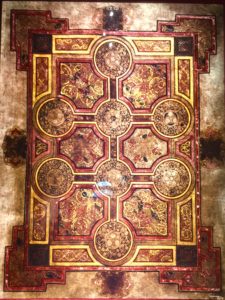
A double-armed cross with eight circles, representing the eight days of Christ’s Passion. Book of Kells, folio 33r
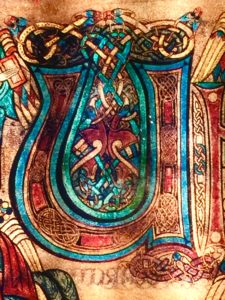
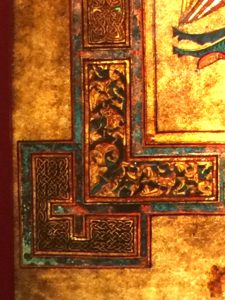
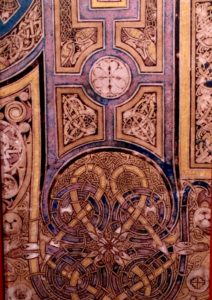
Some of the purple ink is still visible!
If you’d like to see the Book of Kells but aren’t going to make it to Dublin anytime soon, Trinity College has done a fantastic job of scanning the complete book and posting it online. Go to: http://digitalcollections.tcd.ie/home/index.php?DRIS_ID=MS58_003v
 |
| Gaches Mansion in 1891 |
Yesterday, I mentioned how I’d gone to the LaConner Quilt and Textile Museum. This treasure in the Northwest is located in the fabulous Gaches mansion, which was built in 1891. Unfortunately, this landmark suffered a horrendous fire in 1973 and it was questionable whether the mansion would be torn down or rebuilt. Luckily for all of us, a group of LaConner residents were successful in getting the mansion recorded on the National Register of Historic Places and getting a grant for restoration.
 |
| Gaches Mansion Fire in 1973 |
The history of the mansion and the quilt museum which now occupies the historic building is quite fascinating… You can find it in the Museum’s History Section of their website.
 |
| Gaches Mansion today |
The museum is now closed through mid-February for interior renovation. The main cost is for a fire-suppression system… rather a necessity, don’t you think? As of today, Jan 3, 2012, they still need to raise $950 more for the fire suppression. If you want to donate to a worthy cause, please go to their website and click the “Make a Donation” button.
 |
| Dragon Moon Kimono by Cathy Erickson |
The quality of the shows at the museum is incredible. I was able to see two exhibitions. The first was the “Best of the Festival” featuring all the amazing award-winning quilts from the yearly LaConner Quilt Fest, an International juried show. The entrants in this show include so many award-winning quilters that they have made “Masters” divisions for those who have won major awards in the past versus the Open divisions (so up and rising quilters will get their chance to win without having to compete against the Masters.) The winner of the “Best Machine Quilting” for the whole show was Cathy Erickson (mentioned in yesterday’s post) with her “Dragonfly Moon Kimono” pictured here.
 |
| Detail of Cathy Erickson’s “Dragon Moon Kimono” |
When you look at the detail of this quilt, you can get a sense of how utterly amazing Cathy’s quilting is. She is a master at micro-quilting. The little overlapping circles (a common Japanese-styled quilting pattern) are only about 1/4″ across. If I hear of Cathy doing any classes or demonstrations, I’ll be sure to let you know (as soon as I get signed up!)
I guess my main point tonight is just how important it is to expose yourself to art that you find inspirational. Because of seeing Cathy’s quilt last week, I was inspired to try out micro-quilting. Of course, not everyone has such a resource practically in their backyard, but that’s what is wonderful about the internet and blogging is that you can find inspiration every day. I hope you’ll go ahead and start on your own 5×7 challenge piece today and be ready to reveal your first week’s art on Tuesday January 8.
By the way, thanks to Carol from “Landscape Lady” who recommended that we get a flickr group for sharing our photos. I’m setting it up and will have it ready before Tuesday. More on the shows I saw in La Conner coming soon!
You might also be interested in:
52 Week Challenge to Readers
Getting Started Might be the Hardest Part
Designing for a Theme
 And when the sun breaks through, it’s glorious! We are surrounded by mountains and water, both freshwater lakes and rivers and the salt water of Puget Sound. With the higher rain level and temperate climate, our native species include many which have given us our “Evergreen State” name.
And when the sun breaks through, it’s glorious! We are surrounded by mountains and water, both freshwater lakes and rivers and the salt water of Puget Sound. With the higher rain level and temperate climate, our native species include many which have given us our “Evergreen State” name. In Springtime, the Skagit Valley tulip festival attracts people from around the world. With acres upon acres of tulips (or earlier in the spring, daffodils), the beauty is legendary.
In Springtime, the Skagit Valley tulip festival attracts people from around the world. With acres upon acres of tulips (or earlier in the spring, daffodils), the beauty is legendary. I hope you enjoy these beautiful skies and the Cascade Mountains as much as I did!
Sunshine and Sand
Pacific Madronna
Finding Inspiration Every Day
Here in the Northwest, beautiful trees and greenery surround us. Having such a lush environment sometimes makes me a little unaware of the splendor of the amazing foliage I see each day. However, the Pacific Madrona (or Madrone) stands up and screams “Look at me!” The distinctive red-rust bark is noticeable from afar, yet gets even more interesting as you get closer. The bark seems to go in cycles with the rusty outer layers peeling off and uncovering an under-layer of nearly florescent lime green bark. It has dimples and crags, as if it has been through really rough times. 
Now, the Madrona tree does often grow along the rocky Pacific coastline, so it can see its share of harsh winds and weather. However, seeing these majestic beauties in areas surrounds with other trees, where they aren’t subject to undue forces from Mother Nature, they still show all the pock marks and unique characteristics which make them so fascinating.
I hope you enjoy these photos I’ve taken of a few Pacific Madronas. Expressing them in fiber is on my list!
You might also enjoy:
Skagit Skies
Sunshine and Sand
Finding Inspiration Every Day
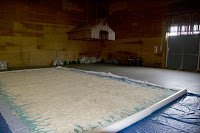 |
| Large Unfinished Feltwork at Tieton |
Have you ever heard of scope creep? Sounds like some kind of peeping tom that uses a periscope, doesn’t it? Well, it’s actually where the intent and expectations of a project keeps increasing. Perhaps I just have big ideas… but I’m finding myself being really excited about the prospects of the Tieton exhibition. For instance, the large felted piece that I mentioned yesterday? I started thinking about a documentary on Mongolia I’d seen and how they would felt large pieces by pulling the roll behind horses. Here’s a link that has some info on the Mongolian felting tradition, as well as a YouTube video of the steps of the process. Well, I’m a horsewoman… I recently sold my horse but still ride and know lots of people in the equestrian community. One of my contacts has a Friesian farm in the Yakima area, not terribly far from Tieton, where they have big beautiful black horses that draw carriages. Shouldn’t be too hard to drag a roll of felt, then, should it?
 |
| Will and Teresa Bron with two of their lovely Friesians |
I also got to thinking about a fiber group whom I read about in Quilting Arts Magazine (June/July 2012). They are from the Netherlands and create all sorts of outdoor installations. You can see some of their work on their Windkracht 10 Blog. We also have had a wonderfully colorful addition to many of our outdoor spaces here in the Seattle area… yarn bombing. Just google yarn bomb Seattle images. Here again, Tieton would be a perfect place to do all sorts of wonderful outdoor fiber art displays. So, the scope of this exhibition may just be creeping up a bit more.
I’m thinking that it might be too much to ask of our CQA artists to also do the outdoors pieces, so perhaps I’ll just write an open call for artists in Washington… that shouldn’t be too much extra work, right?
Tieton would also like to have lecturers and classes available from fiber artists during the show run. So, I’ve opened this up to CQA artists as an opportunity, but I may need to open it further, if I don’t get enough response. Well, I suppose I could pull a class together before next May….
Oh, and I’m thrilled that Mighty Tieton, having their own print studio, has offered to make a catalog of the exhibit! All I need to do is provide high resolution images of all the artwork, artist statements, information on each piece, and write a curators statement. No problem!
As you can see, it’s easy to commit and commit, and then not take time to do your art. I’m committed to make a piece (or more) for this show. But as artists we need to weigh out our commitments and look at our overall goals. I do believe that putting this show on in style will be a positive experience for my artistic career. But the major sticking point that I struggle with is in making enough art. Making enough to be good. Making enough to develop my artistic voice. Making enough to feel fulfilled. As I work through my goals for the coming year, I’m looking at committing to making a small art piece (5×7?) each week. However, I struggle with whether that will stop me from making my larger pieces. I have a partially-completed quilt (OK, who doesn’t) on my design wall that is about double-bed sized… I don’t want to stop making something just for the sake of some promise to do a small piece every week. And I’m not sure I have time for both. Well, I guess I will think it through some more before I write out my goals and plans for 2013!
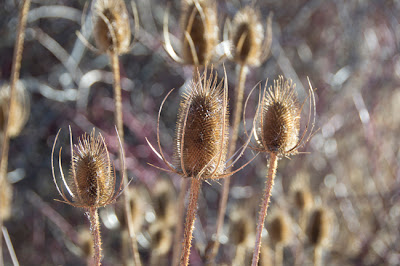 |
| Eastern Washington Seed Pods |
Here’s my favorite inspiration from my day! The sunshine and shadows on these seedpods was lovely with crisp air filled with the smells of all the dried grasses and grains.
 One area in which I never have any difficulty is finding inspiration. If anything, I’m too willing and see beauty and interest in too many things. Right now, my husband, Randy, is watching some of the post-Thanksgiving college football games and I can glance up at the commercials and see the artistic talent and incredible genius in the commercials. The marketing wizards of television advertising create such compelling imagery, as well as often having incredible auditory stimulus.
One area in which I never have any difficulty is finding inspiration. If anything, I’m too willing and see beauty and interest in too many things. Right now, my husband, Randy, is watching some of the post-Thanksgiving college football games and I can glance up at the commercials and see the artistic talent and incredible genius in the commercials. The marketing wizards of television advertising create such compelling imagery, as well as often having incredible auditory stimulus.
 Today we drove across the Cascade mountain range from Western Washington to Eastern, where my husband loves to hunt. It is with a bit of trepidation that I mention this activity. I grew up in the suburbs of Seattle, and with the exception of a short couple months living in San Francisco and many years of living in the Seattle city limits, I have found myself living back in Bellevue, a short distance across Lake Washington from Seattle. I bring this up in contrast to how my husband was raised, in the rural countryside of Minnesota. Having been brought up in suburbia, I don’t remember anyone that I know of having guns or being a hunter. My impression of hunters was probably pretty biased… radical right-wingers… card-carrying NRA members… although I didn’t have any real ethical problem with hunting, so long as they would eat the meat, rather than just killing for sport. Even after several years of having been a vegan in my past (a vegetarian who eats no animal products at all, including meat, poultry, fish or dairy) and having studied the issues of being a carnivore, I feel like that hunting or fishing at least gives the animal/bird/fish some change at survival and a better quality of their life than most creatures that are farm-raised. In contrast, Randy grew up with pheasant hunting every year with his father. It’s a very nostalgic activity for him. Regardless, I know that there are plenty of people who are anti-hunting. So I tend not to mention this aspect of our life to many people, for fear of their reaction or rejection.
Today we drove across the Cascade mountain range from Western Washington to Eastern, where my husband loves to hunt. It is with a bit of trepidation that I mention this activity. I grew up in the suburbs of Seattle, and with the exception of a short couple months living in San Francisco and many years of living in the Seattle city limits, I have found myself living back in Bellevue, a short distance across Lake Washington from Seattle. I bring this up in contrast to how my husband was raised, in the rural countryside of Minnesota. Having been brought up in suburbia, I don’t remember anyone that I know of having guns or being a hunter. My impression of hunters was probably pretty biased… radical right-wingers… card-carrying NRA members… although I didn’t have any real ethical problem with hunting, so long as they would eat the meat, rather than just killing for sport. Even after several years of having been a vegan in my past (a vegetarian who eats no animal products at all, including meat, poultry, fish or dairy) and having studied the issues of being a carnivore, I feel like that hunting or fishing at least gives the animal/bird/fish some change at survival and a better quality of their life than most creatures that are farm-raised. In contrast, Randy grew up with pheasant hunting every year with his father. It’s a very nostalgic activity for him. Regardless, I know that there are plenty of people who are anti-hunting. So I tend not to mention this aspect of our life to many people, for fear of their reaction or rejection.
 |
| mini crab-apples |
 As a lover of animals, I’m relieved that my husband only hunts upland birds (pheasant, quail, and chucker.) I’m pretty good with training, both dogs and as a horsewoman. So my participation in the past years has been to train and maintain control of our hunting dog. Yet for the first time this year, my two teen boys passed their hunter education and I took the class with them, so I’m actually participating in the hunting. I guess I should say for those who’ve never gone hunting, that it’s a lot like fishing… it’s a good day when you see a bird- but many times you don’t. If you really want to bring home dinner, you pay to go to a bird farm/hunting club, where they place farm-raised birds which you buy (regardless of whether you actually get the bird or not) in a field for you to hunt. The real joy is in being out in the field watching your dog do what he/she is raised to do and love.
As a lover of animals, I’m relieved that my husband only hunts upland birds (pheasant, quail, and chucker.) I’m pretty good with training, both dogs and as a horsewoman. So my participation in the past years has been to train and maintain control of our hunting dog. Yet for the first time this year, my two teen boys passed their hunter education and I took the class with them, so I’m actually participating in the hunting. I guess I should say for those who’ve never gone hunting, that it’s a lot like fishing… it’s a good day when you see a bird- but many times you don’t. If you really want to bring home dinner, you pay to go to a bird farm/hunting club, where they place farm-raised birds which you buy (regardless of whether you actually get the bird or not) in a field for you to hunt. The real joy is in being out in the field watching your dog do what he/she is raised to do and love.
 |
| upholstery fabric from restaurant |
OK, how does this relate to finding inspiration? As I said, I find inspiration everywhere. The sky and clouds, the few lone crab-apple trees in the orchard which are inexplicably filled with fruit while most are bare, pieces of wood, fields of grain… these are a few of the things which I viewed today. I also saw some wonderful textiles, again in everyday places- the upholstery at the restaurant we ate at, and a cute applique pillow in our hotel room.

